Abstract
In patients with vascular disease, acute coronary syndromes and ischemic strokes develop suddenly and often unpredictably. In most patients, these clinical scenarios result from arterial thrombosis from one of three mechanisms: plaque rupture, plaque erosion, or calcified nodule. A number of diagnostic modalities have been used in the evaluation of these unstable, high-risk lesions that predispose to arterial thrombosis. Noninvasive MRI allows three-dimensional imaging with evaluation of vascular structures and depiction of components of atherosclerotic plaque. However, noninvasive MRI is limited in the evaluation of arteries of smaller caliber and deeper location, such as coronary, iliac, and renal arteries. To overcome these inherent limitations of noninvasive MRI, invasive approaches have been developed that include intravascular coils for lesion assessment and characterization, and a novel intravascular MRI catheter within which the magnets, radiofrequency transmitters, and receivers are miniaturized. This self-contained MRI catheter holds promise in the in vivo assessment of lipid-rich, potentially vulnerable plaques.
Similar content being viewed by others
References and Recommended Reading
Stary HC: Composition and classification of human atherosclerotic lesions. Virchows Arch 1992, 421:277–290.
Stary HC, Chandler AB, Glagov S, et al.: A definition of initial, fatty streak, and intermediate lesions of atherosclerosis. A report from the Committee on Vascular Lesions of the Council on Arteriosclerosis, American Heart Association. Circulation 1994, 89:2462–2478.
Stary HC, Chandler AB, Dinsmore RE, et al.: A definition of advanced types of atherosclerotic lesions and a histologic classification of atherosclerosis. A report from the Committee on Vascular Lesions of the Council on Arteriosclerosis, American Heart Association. Circulation 1995, 92:1355–1374.
Schwartz SM, deBlois D, O’Brien ER: The intima. Soil for atherosclerosis and restenosis. Circ Res 1995, 77:445–465.
Daugherty A, Pure E, Delfel-Butteiger D, et al.: The effects of total lymphocyte deficiency on the extent of atherosclerosis in apolipoprotein E-/- mice. J Clin Invest 1997, 100:1575–1580.
Daugherty A, Rateri DL: T lymphocytes in atherosclerosis: the yin-yang of Th1 and Th2 influence on lesion formation. Circ Res 2002, 90:1039–1040.
Libby P, Ridker PM, Maseri A: Inflammation and atherosclerosis. Circulation 2002, 105:1135–1143.
Falk E, Shah PK, Fuster V: Coronary plaque disruption. Circulation 1995, 92:657–671.
Burke AP, Farb A, Malcom GT, et al.: Coronary risk factors and plaque morphology in men with coronary disease who died suddenly. N Engl J Med 1997, 336:1276–1282.
Burke AP, Farb A, Malcom GT, et al.: Effect of risk factors on the mechanism of acute thrombosis and sudden coronary death in women. Circulation 1998, 97:2110–2116.
Farb A, Tang AL, Burke AP, et al.: Sudden coronary death. Frequency of active coronary lesions, inactive coronary lesions, and myocardial infarction. Circulation 1995, 92:1701–1709.
Virmani R, Kolodgie FD, Burke AP, et al.: Lessons from sudden coronary death: a comprehensive morphological classification scheme for atherosclerotic lesions. Arterioscler Thromb Vasc Biol 2000, 20:1262–1275.
Kolodgie FD, Burke AP, Farb A, et al.: The thin-cap fibroatheroma: a type of vulnerable plaque: the major precursor lesion to acute coronary syndromes. Curr Opin Cardiol 2001, 16:285–292.
Virmani R, Burke AP, Kolodgie FD, Farb A: Vulnerable plaque: the pathology of unstable coronary lesions. J Interv Cardiol 2002, 15:439–446.
Yuan C, Lin E, Millard J, Hwang JN: Closed contour edge detection of blood vessel lumen and outer wall boundaries in black blood MR images. Magn Reson Imaging 1999, 17:257–266.
Fuster V, Corti R, Fayed ZA, et al.: Integration of vascular biology and magnetic resonance imaging in the understanding of atherothrombosis and acute coronary syndromes. J Thromb Haemost 2003, 1:1410–1421.
Correia LC, Atalar E, Kelemen MD, et al.: Intravascular magnetic resonance imaging of aortic atherosclerotic plaque composition. Arterioscler Thromb Vasc Biol 1997, 17:3626–3632.
Rogers WJ, Prichard JW, Hu YL, et al.: Characterization of signal properties in atherosclerotic plaque components by intravascular MRI. Arterioscler Thromb Vasc Biol 2000, 20:1824–1830.
Larose E, Yeghiazarians Y, Libby P, et al.: Characterization of human atherosclerotic plaques by intravascular magnetic resonance imaging. Circulation 2005, 112:1317–1327.
Larose E, Kinlay S, Selwyn A, et al.: Improved characterization of atherosclerotic plaques by gadolinium contrast during intravascular magnetic resonance imaging of human arteries. Atherosclerosis 2008, 196:919–926.
Yang X, Yeung CJ, Ji H, et al.: Thermal effect of intravascular MR imaging using an MR imaging-guidewire: an in vivo laboratory and histopathological evaluation. Med Sci Monit 2002, 8:113–117.
Hofmann LV, Liddell RP, Eng J, et al.: Human peripheral arteries: feasibility of transvenous intravascular MR imaging of the arterial wall. Radiology 2005, 235:617–622.
Honda Y, Fitzgerald PJ: Frontiers in intravascular imaging technologies. Circulation 2008, 117:2024–2037.
Schneiderman J, Wilensky RL, Weiss A, et al.: Diagnosis of thin cap fibroatheromas by a self-contained intravascular magnetic resonance imaging probe in ex vivo human aorta and in-situ coronary arteries. J Am Coll Cardiol 2005, 45:1961–1969.
Regar E, Hennen B, Grube E, et al.: First in men application of a miniature self-contained intracoronary magnetic resonance imaging probe: a multi-center safety and feasibility trial. Euro Intervent 2006, 2:77–83.
Wilensky RL, Schneiderman J: Intravascular MRI for evaluation of lipid-rich vulnerable plaques in coronary and peripheral vessels. Vasc Dis Manag 2007, 5:22–25.
Dunmore BJ, McCarthy MJ, Naylor AR, et al.: Carotid plaque instability and ischemic symptoms are linked to immaturity of microvessels within plaques. J Vasc Surg 2007, 45:155–159.
Saam T, Underhill HR, Chu B, et al.: Prevalence of American Heart Association type VI carotid atherosclerotic lesions identified by magnetic resonance imaging for different levels of stenosis as measured by duplex ultrasound. J Am Coll Cardiol 2008, 51:1014–1021.
Falk E: Pathogenesis of atherosclerosis. J Am Coll Cardiol 2006, 47:C7–C12.
Wilensky RL, Song HK, Ferrari VA, et al.: Role of magnetic resonance and intravascular magnetic resonance in the detection of vulnerable plaques. J Am Coll Cardiol 2006, 47:C48–C56.
Author information
Authors and Affiliations
Corresponding author
Rights and permissions
About this article
Cite this article
Khadim, G., Nanjundappa, A. & Dieter, R.S. Intravascular MRI. curr cardiovasc imaging rep 2, 293–299 (2009). https://doi.org/10.1007/s12410-009-0034-5
Published:
Issue Date:
DOI: https://doi.org/10.1007/s12410-009-0034-5




